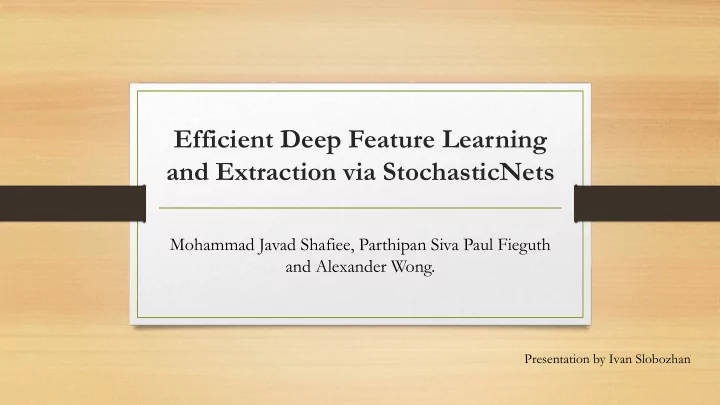

Efficient Deep Feature Learning and Extraction via StochasticNets Mohammad Javad Shafiee, Parthipan Siva Paul Fieguth and Alexander Wong. Presentation by Ivan Slobozhan
Embedded devices and DNN • Low-power CPU • Custom embedded CPU not flexible • Addition costs
Way how to improve • Synaptic formation is stochastic in nature
Random Graphs • Common random graph representation: 𝐻 𝑜, 𝑞 , where 0 < 𝑞 < 1 . • Generalized random graph model: 𝐻 𝑊, 𝑞 )* , 𝑞 ),* 𝜗[0, 1]
Random Graphs Start with 𝑜 vertices 𝑊 = 𝑤 1 1 ≤ 𝑟 ≤ 𝑜 and added 𝐹 = • {𝑓 )* |1 ≤ 𝑗 ≤ 𝑜, 1 ≤ 𝑘 ≤ 𝑜, 𝑗 ≠ 𝑘) . Random graphs with 7 nodes and 𝑞 ),* = 0,5
StochasticNets: Deep Neural Networks As Random Graph Realizations • 𝐻(𝑊, 𝑞 𝑗 → 𝑘 ) , where 𝑊 is a set of neurons 𝑊 = 𝑤 ) 1 ≥ 𝑗 ≥ 𝑜 , with 𝑤 ) denoting the 𝑗 @A neuron and n denoting the total number of neurons and 𝑞 𝑗 → 𝑘 is the probability that neural connection occurs between neuron 𝑤 ) and 𝑤 * .
Constructing DNN as Random Graph • Ensure the properties of the network architecture
FNN as a StochasticNet • No neural connections between non-adjacent layers. • No neural connections between neurons on the same layer. 𝑞 𝑗 → 𝑘 𝑙 → ℎ = 0, 𝑥ℎ𝑓𝑜 𝑗 = 𝑘|| 𝑗 − 𝑘 >
Realization of FFN as a StochasticNet FFN FFN Graph Realization
Relationship to Other Methods
Feature learning via Deep Convolutional StochasticNets • Neural connectivity in the convolutional layers are arranged such that small spatially localized neural collections are connected to the same output neuron in the next layer
Deep convolutional StochasticNet
Spatial neural connectivity models • 𝑞 𝑗 → 𝑘 = G𝑉 0, 1 , 𝑘𝜗𝑆 ) 0, 𝑝𝑢ℎ𝑓𝑠𝑥𝑗𝑡𝑓 − Uniform • 𝑞 𝑗 → 𝑘 = N 𝑂 𝑗, 𝜏 , 𝑘𝜗𝑆 ) 0, 𝑝𝑢ℎ𝑓𝑠𝑥𝑗𝑡𝑓 − Gaussian
CIFAR-10 dataset Gaussian Uniform
STL-10 Gaussian Uniform
Extraction time versus the number of neural connections
Classification using Uniform model
Classification using Gaussian model
Conclusion • DNN could be effectively constructed by stochastic connectivity between neurons. • StochasticNets reduce computation complexity • Provide better or close to ordinary CNN results in feature extractions
Recommend
More recommend